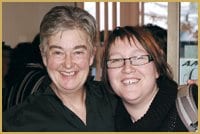Crammed into a soggy bus in the middle of a snowstorm, Nov 29, I wait for a call cancelling the interview. Instead, when I get to the Britannia Centre I am greeted by a group of nearly 20 queer seniors, chatting and munching. In this weather, BC Transit isn’t very reliable, yet these people somehow managed to get here with time left over for snacks.
Claire Robson greets me and introduces me to the group with a holler and a broad sweep of her hand. It is obvious Robson’s inner beauty has preserved her outer beauty. She, along with Chris Morrissey of The Centre’s Generations Project, has organized this workshop series entitled Mapping our Stories.
Funded by the Smart Fund and the Parks Department; the Arts, Health, and Seniors Project is meant to study the effect of creative expression on seniors’ health. As well as creative writing, the group is learning to employ digital media to tell their stories.
“The information about the project funding came to the Generations Project almost serendipitously,” says Morrissey.
Everyone in the group seems to worship her and it’s not hard to see why.
“One of the things I felt heartened by was that the folks from Arts and Culture at the Parks Board were really keen to have an LGBT group,” she enthuses.
“By the third session, the group rebelled and said they didn’t have enough time to finish their work,” says Robson. “They demanded more funding. I still can’t believe a queer writing group is being funded by the Parks Department.
“The group participants have increased their confidence, particularly where the new media is concerned,” continues Robson. “Some of them didn’t know what a browser was or how to send a photo by e-mail.”
She sees the workshop series as an opportunity to make queer seniors more visible and to create community art; art that could be displayed in seniors’ residences.
The group recently attracted a crowd of 65 people to view an exhibition of its work. Themes range from cozy to dangerous.
“The revelation of my first 10 weeks here was to address that sense of self out in public,” says Harris Taylor, who is only 47 and lives with multiple sclerosis. “I deal with the public by-and-large with this interface of my three-wheeled scooter. It brings up a lot of emotional stuff for me and for other people too I think.”
Taylor doesn’t go out unless she has to, but the group has given her a great social and creative outlet. Formerly a documentary filmmaker, she likes that the workshop gives her a platform from which to tell her own stories as well as providing a place where she can hear others tell theirs.
“I found that by writing and sharing with the class a lot of the stories from my childhood, that I thought were not entirely pleasant things, were hilarious,” she says.
Robert St Julian is 70 but could pass for 60. He found the writing group through Morrissey.
“I approached her about homophobia in the building that I live in,” he recalls. “I was tired of it and I needed to find a way through it.” Before joining the group, St Julian coped by gardening.
“I’m quite visible and very open,” he explains. “After my first year in the seniors’ residence, I was asked if I wanted to look after the rose garden. It was wild and overgrown, and I’ve been working on it for about four years. You wouldn’t believe what’s there. So I was grounded in the rose garden and that’s what left me with my sanity.”
Both St Julian and Douglas Bacon, 61, come from religious backgrounds. St Julian was a devout Catholic and member of Dignity; Bacon is a retired minister in the United Church.
Bacon came to the group through the 411 Seniors Centre. He enjoys the diversity of the group and the sense of emotional safety he finds in it.
“It’s such a wonderful mix of people from such diverse backgrounds,” he says. His exhibition presentation was an examination of melancholy. “It was tough to do but I felt safe doing it.”
Bacon’s story says a lot about his generation. He was 31 when he realized he was gay but stayed married to his wife until the last of his three children went to university. As he recounts his story, I become so enthralled I stop taking notes and pray my tape recorder gets it all.
“The biggest thing was letting go of privilege,” he recalls. “I had lived for 50 years as a successful, tall, white, pleasant-looking, heterosexual, protestant male. When I was not in that role and not in that identity, I floundered.
“There are so many automatics that come as soon you walk into the room with your wife and your three children. All of that stuff gives you an identity and a status in the community that is just not there for gay men.”
The group wraps up a discussion about what counts as queer art and crowds around a PowerBook to see a series of photographs by one of the participants. Someone comments on the photo’s composition and explains the concept of digital resolution.
None of these people look like what I would consider to be senior.
“I did a workshop recently at the Positive Gathering with older, positive gay men,” says Robson. “It was interesting to think about being gay, old, HIV-positive and having survived. Most of those guys didn’t think they’d be alive to be old.”
“There’s going to be more and more of us who are out and visible,” she continues. “I’m 64 and my partner is 74 so we’re on the cutting edge, but you better be ready because there’s a whole bunch of us coming up from behind.”

 Why you can trust Xtra
Why you can trust Xtra


